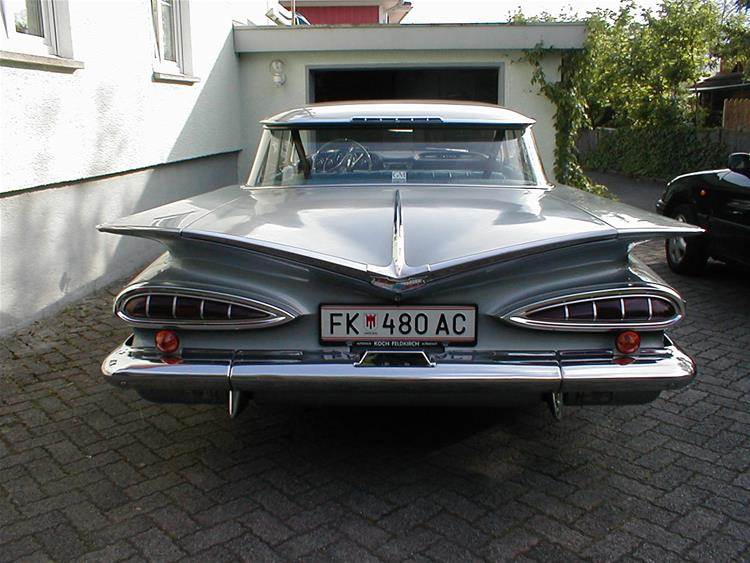The Impala was introduced for the 1958 model year as top of the line Bel Air hardtops and convertibles. From the windshield pillar rearward, the 1958 Bel Air Impala differed structurally from the lower-priced Chevrolet models. Hardtops had a slightly shorter greenhouse and longer rear deck. The wheelbase of the Impala was longer than the lower priced models, although the overall length was identical. Interiors held a two-spoke steering wheel and color-keyed door panels with brushed aluminum trim. No other series included a convertible.
The 1958 models were longer, lower, and wider than its predecessors.[7] The tailfins of the 1957 were replaced by deeply sculptured rear fenders. Impalas has three taillights each side, while lesser models had two and wagons just one. Crossed-flag insignias were attached above the side moldings, as well as bright rocker moldings and dummy rear-fender scoops. 1958 was the first year of dual headlamps.

For 1958, GM was promoting their fiftieth year of production, and introduced Anniversary models for each brand; Cadillac, Buick, Oldsmobile, Pontiac, and Chevrolet.[8] The 1958 models shared a common appearance on the top models for each brand; Cadillac Eldorado Seville, Buick Roadmaster Riviera, Oldsmobile Holiday 88, Pontiac Bonneville Catalina, and the all-new Chevrolet Bel-Air Impala.
The standard perimeter-type frame was abandoned, replaced by a unit with rails laid out in the form of an elongated “X.” Chevrolet claimed that the new frame offered increased torsional rigidity[6] and allowed for a lower placement of the passenger compartment. This was a transitional step between traditional construction and the later fully unitized body/chassis, the body structure was strengthened in the rocker panels and firewall.[9] However, this frame was not as effective in protecting the interior structure in a side impact crash, as a traditional perimeter frame.
A coil spring suspension replaced the previous year’s rear leaf springs, and an air ride system was optional. A 283 cu in (4,640 cc) engine was the standard V8, with ratings that ranged from 185 to 290 horsepower. A “W” block (not to be confused with the big-block) 348 cu in (5,700 cc) Turbo-Thrust V8 was optional, producing 250 hp (190 kW), 280 hp (210 kW), or 315 hp (235 kW). The Ramjet fuel injection was available as an option for the Turbo-Fire 283 V8, not popular in 1958.
A total of 55,989 Impala convertibles and 125,480 coupes were built representing 15 percent of Chevrolet production. The 1958 Chevrolet Bel Air Impala helped Chevrolet regain the number one production spot in this recession year.


1958 Chevrolet Bel Air Impala Sport Coupe
Third Generation
The Impala was restyled on the GM B platform for the first time for 1961. The new body styling was more trim and boxy than the 1958–1960 models. Sport Coupe models featured a “bubbleback” roof line style for 1961, and a unique model, the 2-door pillared sedan, was available for 1961 only. It was rarely ordered and a scarce collectible today. The rare Super Sport (SS) option debuted for 1961. This was also the last year the top station wagon model would bear the Nomad name. Power brakes were $43.[13]
1962 Edit
The 1962 model featured new “C” pillar styling for all models except the 4-door hardtop. Sport Coupe models now featured the “convertible roof” styling, shared with other GM “B” full-size hardtop coupes. This style proved extremely popular, and contributed to the desirability of the 1962–1964 Impalas as collectibles. The “overhang” roof style of the sedans was replaced with a more attractive, wider “C” pillar with wraparound rear window. Engine choices for 1962 settled down, the 348-cubic-inch (5.7 L) V8 discontinued and replaced by the 380 brake horsepower (280 kW) 409-cubic-inch (6.7 L)or 409 bhp 409 cubic inch engine. These engines could only be ordered with a manual shift transmission. The small-block 283 was offered with a two barrel carburetor. The 283 was also enlarged to 327 cubic inches (5.4 L),offered in two versions, one with 250 brake horse power and one with 300 brake horse power. Which added more engine choices for small-block fans. The Beach Boys produced a hit single, “409,” referring to the Chevrolet, which became an iconic song for these cars. Impalas again featured premium interior appointments, plusher seats pillar mounted seat belts as well as lap belts also this could be done by the dealerships on customer request.And more chrome trim outside, including a full-width aluminum-and-chrome panel to house the triple-unit taillight assembly. Super Sport (SS) models featured that panel in a special engine-turned aluminum, which was also used to fill the side moldings, making the SS more distinctive in appearance. Impala also gains the top station wagon after the Chevrolet Nomad is gone. Due to reliability problems, the optional Turboglide automatic transmission was discontinued, leaving Powerglide the only automatic transmission available until 1965. A new radio was optional.[11]
1963 Edit
1963 Impala SS Hardtop Sport Coupe
The 1963 Impala featured rectilinear styling with an engine-turned aluminum rear taillight panel surrounded by a chrome border on SS models. Engine choice was similar to 1962, with the small-block 283-and-327-cubic-inch (4.6 and 5.4 L) V8s most popular. The Sport Sedan featured a new, creased roof line. A new “coved” instrument panel with simple indicator lights for hot and cold engine conditions. An optional factory tachometer was built into the dashboard, just above the steering wheel; it was rarely ordered.
1964 Edit
For 1964, the Impala was restyled to a more rounded, softer look. The signature taillight assembly had an “upside-down U” shaped aluminum trim strip above the taillights, but the individual lights were surrounded by a body-colored panel. The 409-cubic-inch (6.7 L) returned as the big-block option, as well as the 2X4 carburetor setup for the 425 horsepower motors. SS models continued to feature the engine-turned aluminum trim. Rooflines were carried over from 1963 unchanged. Back-up lights were standard.
Right hand drive cars were made at GM’s Oshawa plant in Canada and often shipped overseas in kit form for assembly in South Africa and New Zealand. The RHD cars — Chevrolet or equivalent Pontiac (built on Chevrolet frames and using Chevrolet engines in Canada) — all used a right hand drive version of the left hand drive 1961 Pontiac dashboard.

Fourth Generation
Redesigned in 1965, the Impala set an all-time industry annual sales record of more than 1 million units in the U.S.. All new full-size Chevrolets eschewed the “X” frame for a full-width perimeter frame, a new body which featured curved, frameless side glass (for pillarless models), sharper angled windshield with newly reshaped vent windows, and redesigned full-coil suspension.
1966 Impala SS Convertible
In 1965 Chevrolet introduced the Impala Caprice, exclusively as a four-door hardtop. Caprices received tufted upholstery, wood grained accents on the dashboard and specialty pulls on the insides of the doors. This “halo” model also featured the “spinner” wheel covers from the Impala SS, with the “SS” logo centers replaced by a Chevrolet “bowtie” emblem. The Super Sport’s blackout rear trim strip below the triple taillights was also used, with the “Impala SS” emblem deleted of course. The Caprice Custom was reintroduced as the Chevrolet Caprice in 1966, taking the top position in the full-size Chevrolet lineup.
Engine choices included the inline six-cylinder as well as the small-block and big-block V8s. A newly three-range Turbo Hydra-Matic automatic transmission was optional for 396 cu in (6.5 L) V8. The old 409-cubic-inch (6.7 L) “W” engine was discontinued early in the 1965 model year, so early-production 1965s got the 409, as well as 1/10 of 1% had the 396 CID big-block. Other later-built cars had the 396-cubic-inch (6.5 L) as the big-block option. Two-speed Powerglide, as well as 3- and 4-speed manual transmissions were available. As with previous years, Impalas featured more chrome trim inside and out, with pleated tufted upholstery and door panels. The Impala would be the #2-selling convertible in the U.S. in 1966, with 38,000 sold; it was beaten by the Mustang by almost 2:1.[18]
The 1967 model was redesigned with enhanced Coke bottle styling which featured Corvette-inspired front and rear fender bulges. The curves were the most pronounced with the 1967–1968 models. In keeping with federal regulations, safety features were built into Impalas during the 1967 and 1968 model years, including a fully collapsible energy-absorbing steering column, side marker lights, and shoulder belts for closed models. A black 1967 Sport Sedan 4-door hardtop was used in the television series Supernatural, and as such, this model has seen a substantial increase in value to collectors.
1968 Impala Sport Coupe
The 1968 model was facelifted with a new front end, The new rear bumper housed triple “horseshoe” shaped taillights. 1968 also saw a new Impala model, the Custom Coupe. This two-door hardtop featured the same formal roofline as the Caprice Coupe. It was a huge commercial success and would be continued right through 1976.
The 1969 Impala and other full-sized Chevrolets got new slab-sided bodies with a small “upsweep” at the rear quarter window, giving them a more formal appearance. It retained the 119-inch wheelbase from previous models. New front bumpers that wrapped around the grille and horizontal taillights were in the rear bumper. The hardtop Sport Coupe got a new, crisply styled notchback roofline, replacing the “fastback” C-pillar from 1967 to 1968. Ventless front windows were used on all models. Chevrolet had a rudimentary “power vent” system featuring vents in the instrument panel. The ignition switch was moved from the instrument panel to the steering column, and when the key was removed, the steering wheel and shift lever were locked.
The 1969 model year Impala production topped Caprice production by 611,000 units. Impala station wagons were renamed Kingswood, a name which would continue through 1972. The similar 1970 Impala got a minor facelift featuring a more conventional under the grille bumper replacing the wrap-around unit used in 1969 along with new triple vertical taillights in the rear bumper. Canadian buyers got the choice of a lower priced companion to the Impala Sport Coupe, the Bel Air Sport Coupe, which used the same body but featured Bel Air trim.





